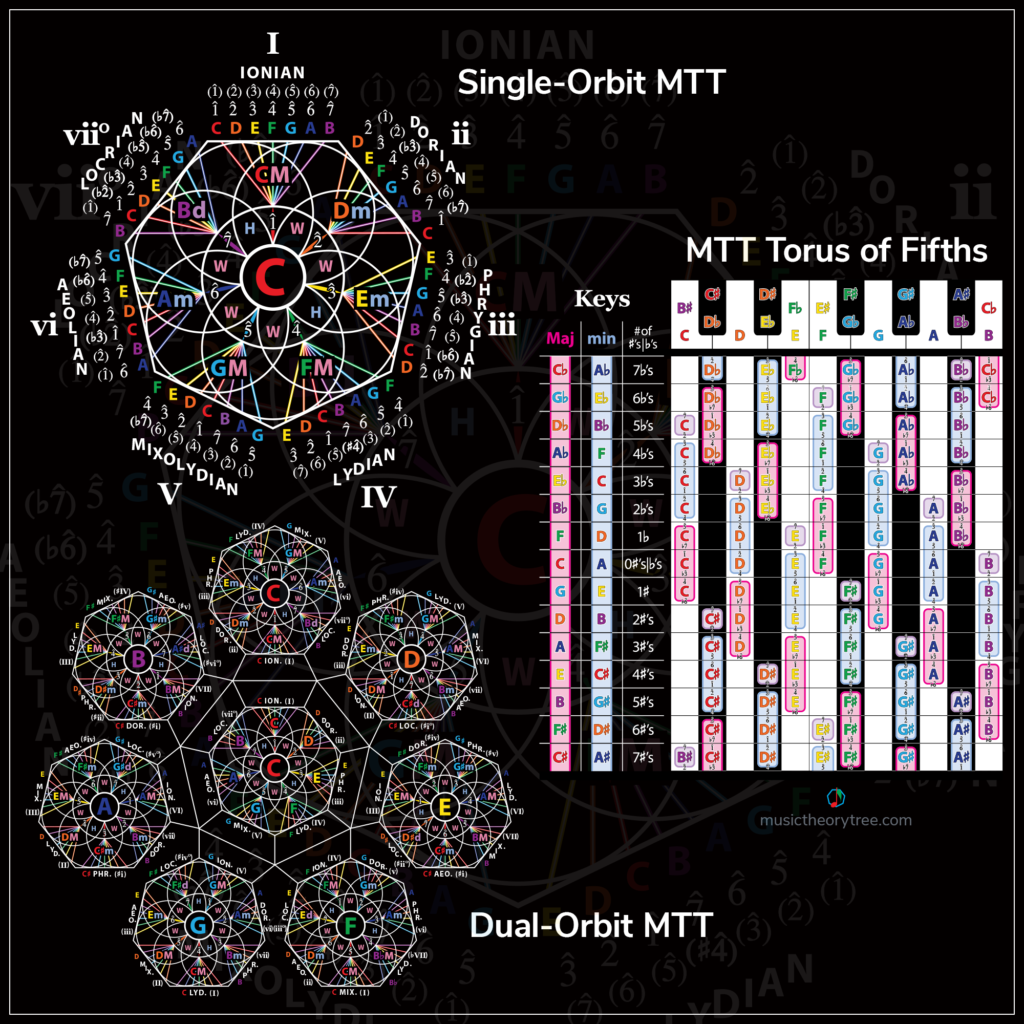

Music Theory Tree is an innovative, visual approach to teaching and learning music theory. Using a systematic set of shapes and musical symbols, the Music Theory Tree Maps show the relationships between fundamental music theory concepts.
These include everything from pitch classes, scale degrees, and intervals, to chords, modes, keys, and beyond; all combined into one colour-coded, intuitive system. It may be used to describe and study any major or minor scale, or other heptatonic scales, such as harmonic minor, melodic minor, and harmonic major.
It may be expanded to its Dual-Orbit version to show the fractal relationships between chords and their parallel keys, or to the MTT Torus of 5ths, for a broad overarching view of Western harmony.
The Music Theory Tree System may be used to assist with learning and teaching musical composition in any genre, analysis, building chords, or as a tool for finding fun and diverse chord progressions and melodies.
See below for more details on each design.
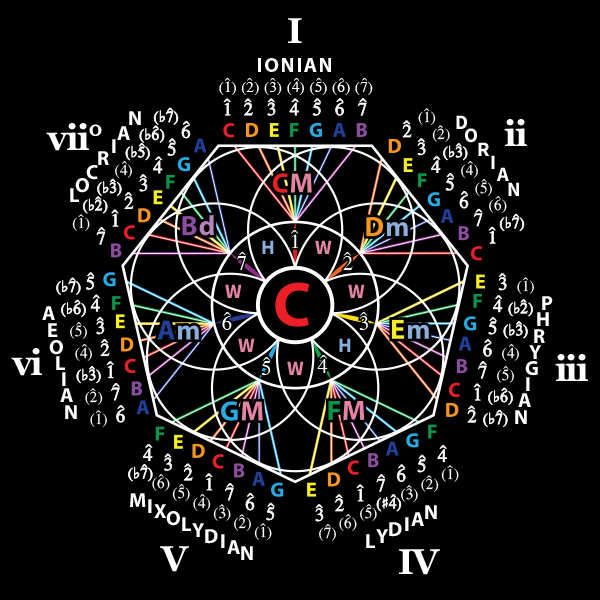
The original Music Theory Tree, allows one to paint a colour-coded picture in one’s mind that connects all of the pitch classes of a scale, and the intervals that separate them. This allows one to make connections between the chords in a musical key, and how they correspond to given scale degrees, by tracing the paths between vertices in a seven-circle venn diagram. This is all housed inside a simple, seven-sided polygon called a heptagon.
By repeatedly completing “MTT – Level 1: Grow a Music Theory Tree,” for all musical keys, one can quickly learn the notes and chords in every key, how they function harmonically, and begin to recognize visually which chords are shared between multiple keys. For a deeper understanding, one may begin to explore the Dual-Orbit Music Theory Tree. See below.
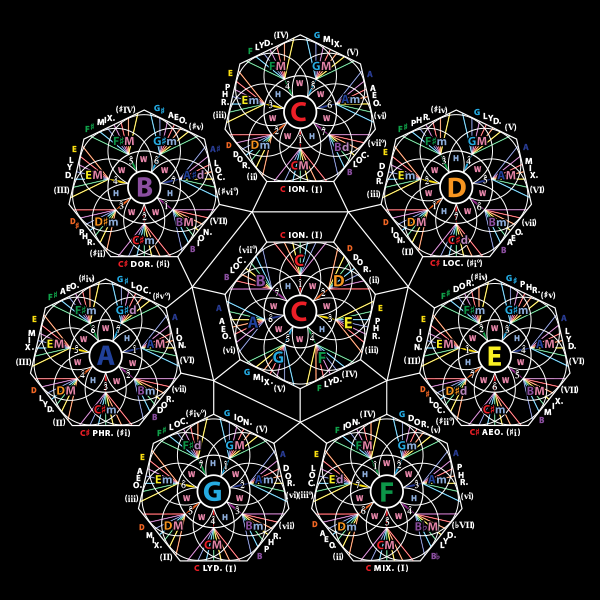
Once one has a foundation for how notes and chords connect within a single key, and wants to take it a step further to understand modulations and key changes through compositional techniques like modal interchange, the Dual-Orbit MTT takes the Single-Orbit and shows one how chords or even pitches in a given key can be transformed into their own key centers.
The edges of the heptagon all align at distinct angles, which means that for one to see how a note or a chord of a given pitch class changes from key to key, one may simply look to the parallel lines in the diagram for their answers. By filling out multiples of “MTT – Level 4: Parallel Transformations,” one may gain an even deeper understanding of the interconnectedness and fractal nature of musical notes, chords, and keys.
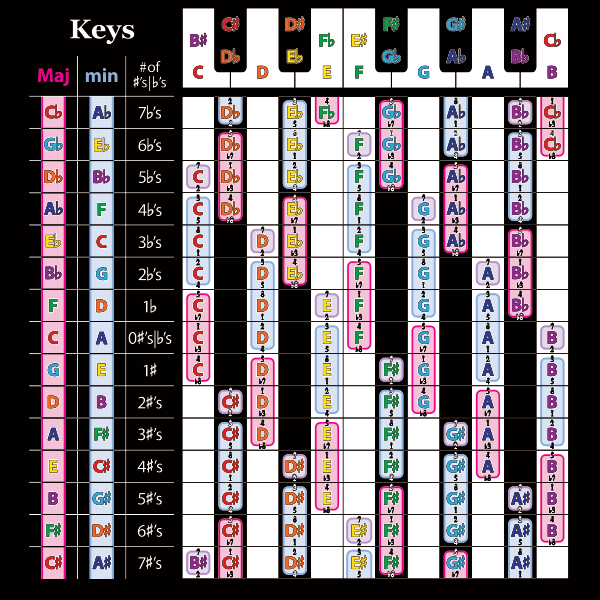
Any musician whose mission it is to strategically learn how all musical keys fit together in the simplest way possible, and explore further the philosophy that “notes become chords, which become keys” intrinsic to Western music theory, will undoubtedly appreciate the MTT Torus of Fifths.
An expanded, intuitive reimagining of the legendary Circle of Fifths, it takes all of the colourful concepts from Single and Dual-Orbit Music Theory Trees, and displays them in a rectangular grid. This way, one may see the connections between the pitch classes, scale degrees, and chords, in all diatonic systems.
Each column represents a different pitch class in 12-Tone Equal Temperament.
Horizontal rows represent diatonic systems. Moving horizontally allows one to investigate relative modes of a given scale.
After one completes “MTT – Level 1: Grow a Music Theory Tree”, and “MTT – Level 4: Parallel Transformations”, for all key centers, it is recommended that one takes their new understanding of musical interconnectedness and completes the “MTT – Level 5: Torus of Fifths” exercise. Doing so carefully and observantly even once is likely to reveal to the musician many music-theoretic patterns relevant to Western harmony, offering them the potential to incorporate them into their compositions. Completing it multiple times will ensure the best results.
Reach out to Steve Evans From Winnipeg through the, “Contact,” page for help.

Steve Evans From Winnipeg in home studio.
Photo by Mountain Ash Media
The Music Theory Tree Maps and method were designed by Owner & Founder, Stephen Matthew Evans, from Winnipeg, Canada, and illustrated by his close friend, Aaron Fehr.
As an enthusiast of music theory, musical composition, and guitar instruction, Steve Evans From Winnipeg has been studying and teaching this subject since 2006.
He completed an initial sketch of the first Music Theory Tree design on February 23rd, 2019. Shortly after, Steve approached Aaron to assist him in creating professional, visual maps precisely rendered in Adobe Illustrator.
He is producing a comprehensive video series, teaching how to use these unique diagrams, as well as providing virtual lessons over Zoom to enthusiastic music theory and electric guitar students.
His goal is for MTT diagrams to be used by students and teachers in private practices and music schools all over the world.
He hopes that the use of his visual works will one day become common practice in the field of music education.
Stephen dedicates Music Theory Tree in loving memory to his grandparents, Lorne and Martha Evans, who passed away in October of 2018. They were both loving, generous, and brilliant human beings, who shared their passion for music, education, and design with their children and grandchildren.
Stephen thanks you for visiting this page and he looks greatly forward to working with each of you in making learning this subject fun and exciting for all that it reaches. Please help spread the word.
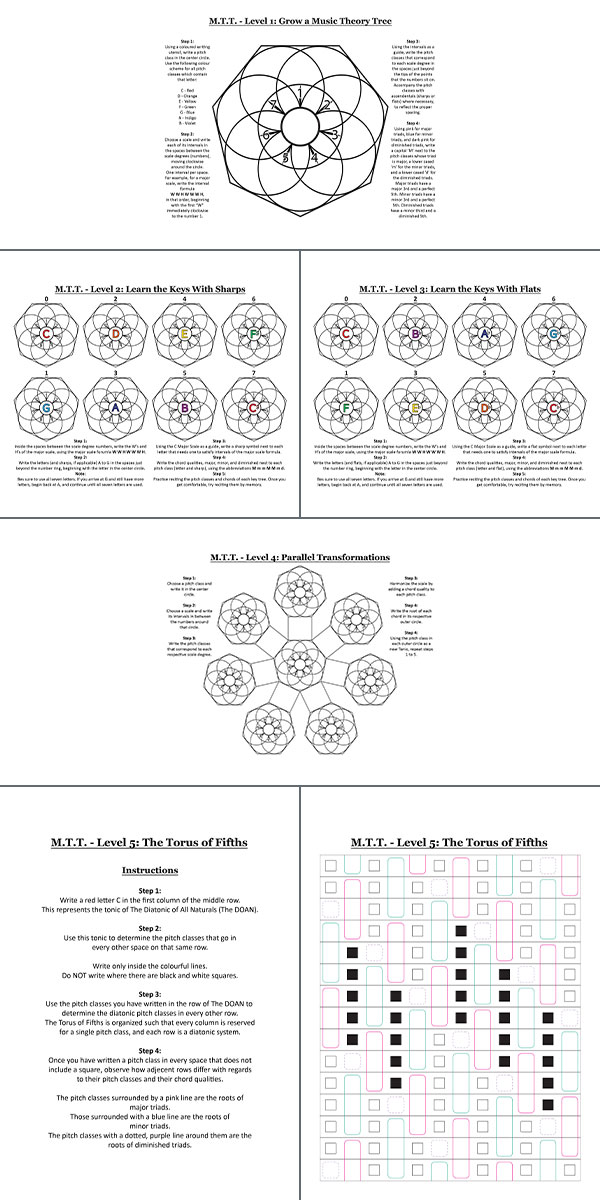
Quickly learn every note, chord, & key, & and apply them across musical styles, using basic shapes and colours. Preview Download
Simply fill out the form below, and I’ll send these fun and effective exercises straight to your inbox.
Get ready to have your mind blown as you simultaneously learn and link together multiple concepts, saving you time to spend on playing music!
